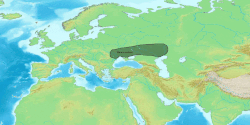
| Part of a series on |
| Indo-European topics |
|---|
 |
The Kurgan hypothesis (also known as the Kurgan theory, Kurgan model, or steppe theory) is the most widely accepted proposal to identify the Proto-Indo-European homeland from which the Indo-European languages spread out throughout Europe and parts of Asia. [1] [2] It postulates that the people of a Kurgan culture in the Pontic steppe north of the Black Sea were the most likely speakers of the Proto-Indo-European language (PIE). The term is derived from the Turkic word kurgan (курга́н), meaning tumulus or burial mound.
Contents
- History
- Predecessors
- Overview
- Kurgan culture
- Cultural horizon
- Stages of culture and expansion
- Timeline
- Further expansion during the Bronze Age
- Revisions
- Invasion versus diffusion scenarios (1980s onward)
- Alignment with Anatolian hypothesis (2000s)
- Anthony's revised steppe theory (2007)
- See also
- References
- Bibliography
- External links
The steppe theory was first formulated by Otto Schrader (1883) and V. Gordon Childe (1926), [3] [4] then systematized in the 1950s by Marija Gimbutas, who used the term to group various prehistoric cultures, including the Yamnaya (or Pit Grave) culture and its predecessors. In the 2000s, David Anthony instead used the core Yamnaya culture and its relationship with other cultures as a point of reference.
Gimbutas defined the Kurgan culture as composed of four successive periods, with the earliest (Kurgan I) including the Samara and Seroglazovka cultures of the Dnieper–Volga region in the Copper Age (early 4th millennium BC). The people of these cultures were nomadic pastoralists, who, according to the model, by the early 3rd millennium BC had expanded throughout the Pontic–Caspian steppe and into Eastern Europe. [5]
Genetics studies in the 21st century have demonstrated that populations bearing specific Y-DNA haplogroups and a distinct genetic signature expanded into Europe and South Asia from the Pontic-Caspian steppe during the third and second millennia BC. These migrations provide a plausible explanation for the spread of at least some of the Indo-European languages, and suggest that the alternative theories such as the Anatolian hypothesis, which places the Proto-Indo-European homeland in Neolithic Anatolia, are less likely to be correct. [6] [7] [8] [9] [10]
